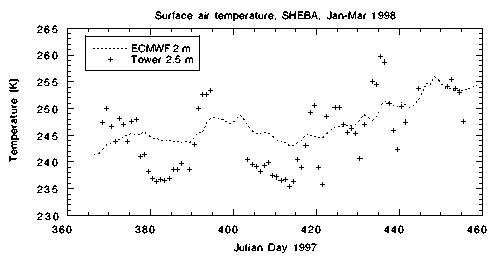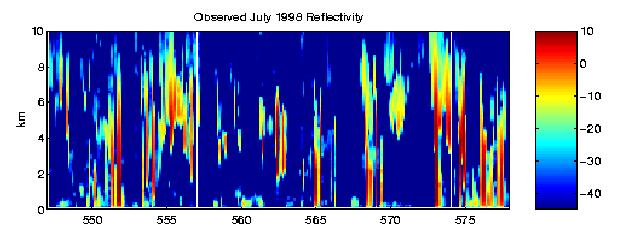- An integrated SHEBA dataset over the annual cycle
A central goal of the Surface Heat Budget of the Arctic Ocean (SHEBA)
experiment was to provide a comprehensive observational test of model
simulations of the atmosphere-sea ice-ocean system over the Arctic
Ocean. This integrated dataset is designed to bring together many of
the observations needed to validate such models, and in particular to
initialize, and force single-column model simulations during all
phases of the annual cycle. We have reduced all observations
to hourly or longer time resolution to keep the data
volume manageable. This data set may also prove useful for
observational analyses that bring together different types of data and
focus on long time intervals.
One crucial boundary condition for such models is the time-varying
tendencies of heat and moisture from horizontal and vertical
advection. Due to the difficulty of directly obtaining these
tendencies, we instead provide hourly tendencies from short-range
(12-35 hour) forecasts at the moving SHEBA column position provided by
ECMWF. These forecasts assimilated
SHEBA rawinsonde soundings
and
surface observations
, and are generally in good agreement with the
observed soundings. You may also link to a larger netcdf file
containing a complete suite of
hourly output from the ECMWF model.
Other datasets include all rawinsonde soundings
,
and hourly-averaged data from
lidar,
radar
,
meteorological surface observations and a microwave radiometer.
An
overall discussion of many of these measurements and how they compare
with the ECMWF predictions can be found in:
Bretherton, C. S., S. R. de Roode, C. Jakob, E. A. Andreas, J. Intrieri, R. E. Moritz, and
P. O. G. Persson, 2000:
A comparison of the ECMWF forecast model with observations over the annual cycle
at SHEBA. Revised version submitted to the
special FIREIII issue of the Journal of Geophysical Research, May 2000.
(Postscript version)
Below, we summarize the different variables we have compiled. We include two tables: first those relevant to model
initialization and boundary conditions, and second the available variables for model verification.
Turbulence
and
tower observations
made during May 1998 by the group of
Peter Duynkerke (2000) have been archived too, as this period is of
special interest as a SHEBA/FIRE.ACE intensive observing period.
Model Initialization and Boundary Conditions
A single-column model can be initialized using the rawinsonde observations, whereas boundary conditions
such as horizontal and vertical advection can be taken from the ECMWF model predictions.
Moreover, continuous surface observations provide information such as surface albedo,
surface pressure and/or turbulent surface fluxes.
The following table summarizes the major variables that are needed for model initialization
and horizontal and surface boundary conditions,
and the names of the files in which they are stored.
|
VARIABLE |
netCDF VARIABLE NAME |
FILE NAME |
|
Temperature |
nc{'temp'} |
rawinsonde.nc |
|
Relative humidity |
nc{'rh'} |
rawinsonde.nc |
|
Wind velocity |
nc{'wtot'} |
rawinsonde.nc |
|
Wind direction |
nc{'wdir'} |
rawinsonde.nc |
|
SHEBA ice camp longitude |
nc{'longitude'} |
surf_obs.nc |
|
SHEBA ice camp latitude |
nc{'latitude'} |
surf_obs.nc |
|
Surface temperature |
nc{'T_sfc'} |
surf_obs.nc |
|
Surface pressure |
nc{'pressure'} |
surf_obs.nc |
|
Tower albedo (*1) |
nc{'tower_albedo'} |
surf_obs.nc |
|
Line albedo (*1) |
nc{'line_albedo'} |
surf_obs.nc |
|
Sensible heat flux (*2) |
nc{'hs'} |
surf_obs.nc |
|
Latent heat flux (*2) |
nc{'hlb_2_5'} |
surf_obs.nc |
|
ustar |
nc{'ustar'} |
surf_obs.nc |
|
roughness length |
nc{'z0'} |
not available yet |
|
Temperature |
nc{'T'} |
EC_tend.nc |
|
Specific humidity |
nc{'qv'} |
EC_tend.nc |
|
u-wind component |
nc{'u'} |
EC_tend.nc |
|
v-wind component |
nc{'v'} |
EC_tend.nc |
|
Omega |
nc{'omega'} |
EC_tend.nc |
|
Total adiabatic u tendency (*3) |
nc{'dudt-adiabatic'} |
EC_tend.nc |
|
Total adiabatic v tendency |
nc{'dvdt-adiabatic'} |
EC_tend.nc |
|
Total adiabatic temperature tendency |
nc{'dTdt-adiabatic'} |
EC_tend.nc |
|
Total adiabatic moisture tendency |
nc{'dqdt-adiabatic'} |
EC_tend.nc |
|
u tendency due to horizontal advection |
nc{'dudt-hor-adv'} |
EC_tend.nc |
|
v tendency due to horizontal advection |
nc{'dvdt-hor-adv'} |
EC_tend.nc |
|
T tendency due to horizontal advection |
nc{'dTdt-hor-adv'} |
EC_tend.nc |
|
qv tendency due to horizontal advection |
nc{'dqdt-hor-adv'} |
EC_tend.nc |
(*1) The downward-pointing pyranometer at the flux tower measured upwelling shortwave
radiation from a small area that mainly consisted of bare ice during the summer melt season.
The surface albedo calculated from this measurement ('tower_albedo') was similar to other SHEBA estimates
(line-averaged or aerial estimates that averaged across a variety of surface types) in the
winter, but up to 15% higher at times in the late summer.
Between 1 June 1998 and 27 September 1998 Don Perovich measured the albedo along a 300 m
line ('line_albedo') cutting across a variety of surfaces (Perovich et al. 1999),
which is in reasonable agreement with aircraft
observations (Curry et al. 2000).
(*2) The sensible heat flux ('hs') was measured by a sonic anemometer. The eddy-correlation
measurements of the latent heat flux however are not very accurate so we recommend the use
of bulk estimates ('hlb_2_5') computed from the observed vertical profiles of the relative humidity
at the SHEBA tower.
For May 1998
turbulent surface fluxes
are available from the group of Peter Duynkerke.
(*3)The total adiabatic tendency is the tendency due to advection only.
We also included the tendencies due to horizontal
advection alone, as many single-column modelers use these and omega
rather than the total tendencies.
Note that the horizontal tendency is defined as: (d/dt)hor_tend = -Uhor dot gradh.
For the temperature T the total adiabatic tendency is defined as:
(dT/dt)tot_ad = - Uhor dot gradh T - omega /psurf * (dT/dsigma) + omega/(rho*cp).
Thus the effect of adiabatic compression/expansion is included in this term.
Vertical profiles of variables like temperature can also be taken from the ECMWF model predictions.
However, care should be taken about the model-predicted atmospheric boundary layer structure.
In particular during the Arctic winter season the ECMWF surface temperatures sometimes
significantly differed from the tower
observations. This can be attributed to the sea-ice model which treated sea-ice as an isothermal slab,
which dramatically damped day-to-day surface air temperature fluctuations compared to the observations,
creating 10-15 K errors in surface air temperature, particularly under clear calm conditions.
 Observed and ECMWF model-predicted near surface temperature, for January-March 1998
(Bretherton et al. 2000, Fig. 1a)
Observed and ECMWF model-predicted near surface temperature, for January-March 1998
(Bretherton et al. 2000, Fig. 1a)
Moreover, sharp temperature inversions capping the boundary layer were frequently observed.
Because of of its rather coarse resolution the ECMWF model tends to smear this profile out.
 Example of a rawinsonde sounding and ECMWF model results for 12 UTC 21 February 1998.
(a) shows the model and observed potential temperature and (b) the model and observed
winds and model downward turbulent heat fluxes.
The diamond marks indicate the observed surface potential temperature (left panel) and observed
downward sensible heat flux (right panel) (Bretherton et al. 2000, Fig. 6).
Example of a rawinsonde sounding and ECMWF model results for 12 UTC 21 February 1998.
(a) shows the model and observed potential temperature and (b) the model and observed
winds and model downward turbulent heat fluxes.
The diamond marks indicate the observed surface potential temperature (left panel) and observed
downward sensible heat flux (right panel) (Bretherton et al. 2000, Fig. 6).
Model Evaluation
Observations of the surface turbulent heat fluxes and radiation
can be used to verify the surface energy balance. Microwave
radiometer retrievals provide the water vapor and liquid water paths, and lidar and radar
data give information about cloud presence and cloud phase.
The following table summarizes the major variables that are needed for model verification
and the names of the files in which they are stored.
|
VARIABLE |
netCDF VARIABLE NAME |
FILE NAME |
|
Temperature |
nc{'temp'} |
rawinsonde.nc |
|
Relative humidity |
nc{'rh'} |
rawinsonde.nc |
|
Wind velocity |
nc{'wtot'} |
rawinsonde.nc |
|
Wind direction |
nc{'wdir'} |
rawinsonde.nc |
|
Surface temperature |
nc{'T_sfc'} |
surf_obs.nc |
|
Sensible heat flux |
nc{'hs'} |
surf_obs.nc |
|
Latent heat flux |
nc{'hlb_2_5'} |
surf_obs.nc |
|
ustar |
nc{'ustar'} |
surf_obs.nc |
|
Upward longwave flux |
nc{'LWu'} |
surf_obs.nc |
|
Downward longwave flux |
nc{'LWd'} |
surf_obs.nc |
|
Upward shortwave flux |
nc{'SWu'} / nc{'SWucor'} |
surf_obs.nc |
|
Downward shortwave flux |
nc{'SWd'} |
surf_obs.nc |
|
Liquid water path |
nc{'lwp'} |
surf_obs.nc |
|
Water vapor path |
nc{'wvp'} |
surf_obs.nc |
|
Cloud reflectivity |
nc{'dBZ'} |
radarhh.nc |
|
Cloud base height |
nc{'altitude'} |
lidardata.nc |
|
depolarization (indication of cloud phase) |
nc{'depol'} |
lidardata.nc |
 Observed radar reflectivities for July 1998 (Bretherton et al. 2000, Fig. 9).
Observed radar reflectivities for July 1998 (Bretherton et al. 2000, Fig. 9).
Summary of available data files
Data policy and requested acknowledgements
The datasets are for use by any FIRE/SHEBA
Science Team member.
If you make use of one of these datasets, please
acknowledge the responsible
principal investigators.
References
Beesley, T. A., C. S. Bretherton, C. Jakob, E. L Andreas,
J. M. Intrieri, and T. A. Uttal, 2000: A comparison of the ECMWF
forecast model with observations at SHEBA, J. Geophys. Res.,
submitted 6/99, revised and accepted 12/99.
Postscript version
Bretherton,
C. S., S. R. de Roode, C. Jakob, E. L Andreas, J. Intrieri, R. E.
Moritz, and P. O. G. Persson, 2000: A comparison of the
ECMWF forecast model with observations over the annual cycle at
SHEBA. J. Geophys. Res., submitted 12/99, revised 5/00.
Postscript version
Curry, J. A. and 26 coauthors, 2000: FIRE Arctic clouds experiment. Bull. Amer.
Meteor. Soc.,81, 5 -29.
Duynkerke, P. G., S. R. de Roode, 2000: Surface energy balance and turbulence characteristi
cs
observed at the SHEBA ice camp
during FIRE III. Revised version submitted to the
special FIREIII issue of the Journal of Geophysical Research, April 2000.
Postscript version
Intrieri, J. M., M. D. Shupe, B. J. McCarty, and T. Uttal, 2000: Annual cycle of arctic
cloud statistics from lidar and radar at SHEBA. J. Geophys. Res., submitted May 2000.
Perovich, D. K., T. C. Grenfell, B. Light, J. A. Richter-Menge, M. Sturm, W. B. Tucker III,
H. Eicken, G. A. Maykut, and B. Elder, 1999: SHEBA: Snow and Ice Studies CD-ROM.
Obtainable from D. Perovich, CRREL, 72 Lyme Road, Hanover, NH, USA 03755.
Persson, P. O. G., C. W. Fairall, E. L. Andreas, and P. S. Guest, 2000: Measurements
of the meteorological conditions and surface energy budget near the atmospheric
surface flux group tower at SHEBA, J. Geophys. Res., submitted.


